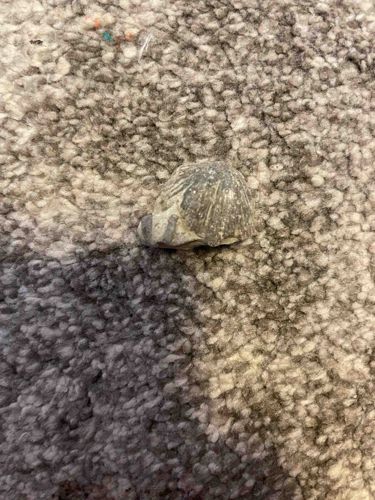
Fossilized Seashell Fragment
The item appears to be a fossilized sea shell or mollusk, likely a partial gastropod or bivalve, exhibiting characteristics consistent with a natural specimen. It is relatively small, with an estimated size of a few centimeters in its longest dimension, and is composed of a grayish-white, stony material, likely limestone or a similar sedimentary rock matrix, embedded with fossilized remnants. The surface displays distinct striations or ribbed patterns, typical of certain mollusk shells, which are indicative of its original biological structure. The color palette is dominated by muted grays and off-whites, with some darker streaks that could be mineral staining or remnants of organic material. The overall shape is irregular, suggesting it is a fragment rather than a complete specimen, with one larger, somewhat conical or rounded section and a smaller, broken-off edge. There are no discernible maker's marks, signatures, or stamps, as is expected for a natural fossil. Its condition appears to be stable, with natural wear and erosion consistent with geological processes, but no apparent recent damage or repairs. The visible patination is natural, reflecting its long burial and exposure. While an exact age cannot be determined without further geological analysis, the presence of these fossilized remains suggests it dates back millions of years to a prehistoric era. The quality and craftsmanship are inherent to nature's processes, showcasing the intricate patterns of ancient life, and it serves as a unique geological artifact.
AI-Generated Appraisal Disclaimer
Estimated Value
$5-20
Basic Information
Category
Natural Specimen
Appraised On
November 28, 2025
Estimated Value
$5-20
Item Description
The item appears to be a fossilized sea shell or mollusk, likely a partial gastropod or bivalve, exhibiting characteristics consistent with a natural specimen. It is relatively small, with an estimated size of a few centimeters in its longest dimension, and is composed of a grayish-white, stony material, likely limestone or a similar sedimentary rock matrix, embedded with fossilized remnants. The surface displays distinct striations or ribbed patterns, typical of certain mollusk shells, which are indicative of its original biological structure. The color palette is dominated by muted grays and off-whites, with some darker streaks that could be mineral staining or remnants of organic material. The overall shape is irregular, suggesting it is a fragment rather than a complete specimen, with one larger, somewhat conical or rounded section and a smaller, broken-off edge. There are no discernible maker's marks, signatures, or stamps, as is expected for a natural fossil. Its condition appears to be stable, with natural wear and erosion consistent with geological processes, but no apparent recent damage or repairs. The visible patination is natural, reflecting its long burial and exposure. While an exact age cannot be determined without further geological analysis, the presence of these fossilized remains suggests it dates back millions of years to a prehistoric era. The quality and craftsmanship are inherent to nature's processes, showcasing the intricate patterns of ancient life, and it serves as a unique geological artifact.
Related Tags
Get Your Items Appraised
Instant estimates of your treasures with AI-powered instant appraisals